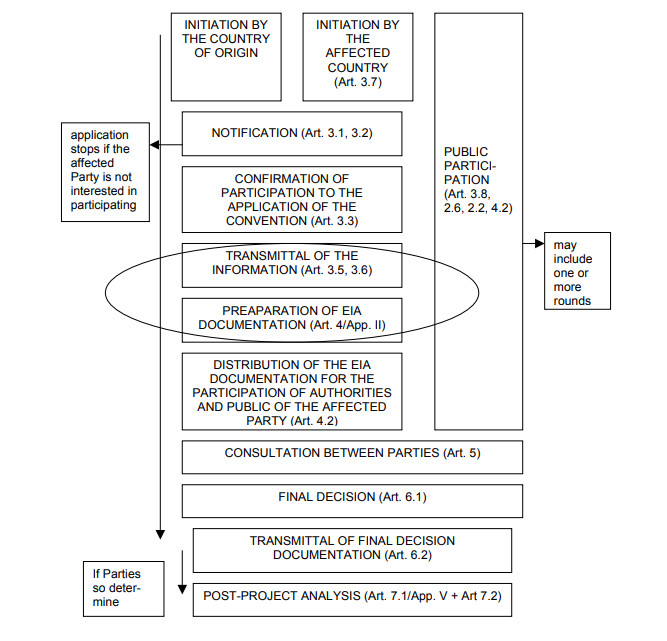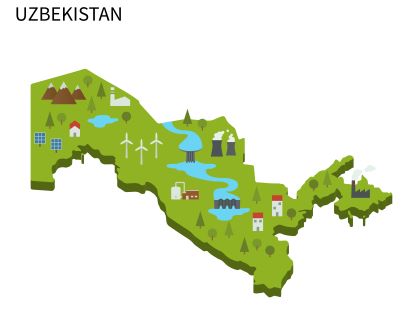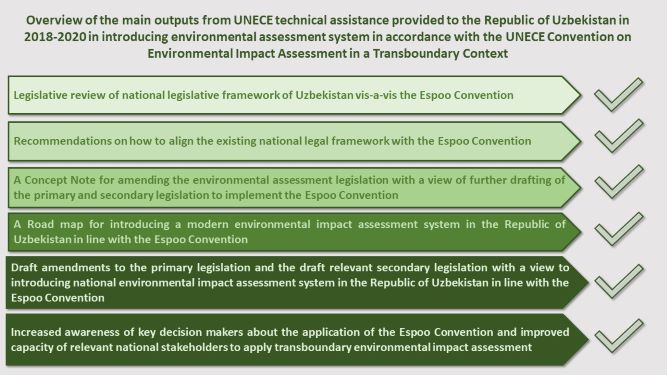Selected Problems of Implementation of the Espoo Convention: On the Example of the Republic of Uzbekistan
.jpg)
Table of Contents
- Human rights and the environment
- The Convention on Environmental Impact Assessment in a Transboundary Context (Espoo Convention)
- Overview of the current situation in the Republic of Uzbekistan
- UNECE assistance to the Republic of Uzbekistan on enhancing national legislative framework in line with the Espoo Convention
- Selected problems of implementation of the Espoo Convention in Uzbekistan and the way to overcome them
- Conclusion
Human rights and the environment
Human rights and the environment are interdependent. A healthy and sustainable environment is a precondition to the enjoyment of human rights, while human rights are tools to address environmental issues. So far, key international human rights treaties do not contain an explicit right to a healthy environment. However, they do recognise the right to life, that can be affected by environmental disasters and degradation.
The first recognition of the close relationship between human rights and the environment was in 1972 at the Stockholm Conference on the Human Environment. Principle 1 of the Declaration of the United Nations Conference on the Human Environment stipulates that the right to adequate conditions of life in an environment of equality is a fundamental right. In 1992 the Rio Declaration on Environment and Development was adopted. The Declaration recognises the importance of preserving the environment. It also sets principles that serve as guidance for the UN Member States in creating national and international environmental policies and legislation.
The progress in defining and enforcing environmental rights lead to the adoption of a number of multilateral environmental agreements (MEAs) that set out obligations on states. Those obligations include facilitation of public participation in environmental decision making and the prevention of environmental damage that could cause an infringement of human rights. Economic, social and environmental change is inherent to development. The need to avoid adverse impacts and to ensure long term benefits of economic activities led to the concept of sustainability.
The United Nations has played a significant role in developing international instruments promoting sustainable development and protecting environmental rights. It has assisted countries, especially those who are in transition, in developing national policies and legislation in line with international standards. The United Nations Economic Commission for Europe (UNECE) is one of five regional commissions of the United Nations aimed at promoting sustainable development. It also focuses on promoting pan-European economic integration and supporting countries in the implementation of the 2030 Agenda for Sustainable Development. Special attention is given to the environmental issues through facilitating international policy dialogue, normative work and capacity-building activities. Based on the country-specific needs and approach, the work of UNECE focuses on strengthening the capacity of the countries in environmental management. Under the auspices of UNECE on 25 February 1991 in Espoo, Finland was elaborated and adopted the Convention on Environmental Impact Assessment in a Transboundary Context (Espoo Convention).
The Convention on Environmental Impact Assessment in a Transboundary Context (Espoo Convention)
The Espoo Convention is one of the most progressive multilateral environmental agreements. It aimed at promoting international cooperation in assessing the likely impact of a proposed activity on the environment in a transboundary context. It also focuses on promoting the right of the public to participate in environmental decision-making and making development sustainable. The Convention sets out the obligations on Parties to assess the potential environmental effects of certain projects, to notify and consult with other Parties (see Figure 1). It helps to ensure that the consideration of environmental factors is given well in advance before the final decision on the proposed activity is taken. The Convention enshrines the right of the public to participate in the environmental assessment, including in a transboundary context. It establishes an effective mechanism for promoting effective implementation of the right of people to participate in environmental decision-making. This, in its turn, contributes to developing good governance and democracy in the country and raising the public trust in governmental decisions.

Figure 1 Flow-chart of the stages of an assessment according to the Convention (Source: UNECE Guidance on the Practical Application of the Espoo Convention, 2006, p.33).
The Espoo Convention has influenced the development of modern environmental assessment system in many countries, including in the Central Asian region. It is the only international instrument that offers a legal framework that helps to ensure international cooperation in assessing the environmental impacts of certain activities in a transboundary context.
An increasing number of countries of the UNECE region has initiated the legislative reforms, the aim of which is to establish a coherent system of incorporation of environmental consideration when making decisions on economic activities. This facilitates the process of introducing green economy policies to enhance national growth and international cooperation.
Overview of the current situation in the Republic of Uzbekistan

Photo: Map of Uzbekistan. Infographic (Source: depositphotos.com)
Uzbekistan is not yet a Party to the Espoo Convention but recently has realised the benefits of the application of the Convention for developing good governance and greening the economy. Currently, Uzbekistan is undergoing a rapid process of economic and social development. This resulted in the process of implementation of comprehensive reforms in the country. The progress in developing the country’s economy, building strong partnerships and transforming into an upper-middle-income country by 2030 can be seen as main priorities for Uzbekistan today. To achieve the highly ambitious goals further comprehensive reforms are required. Special attention should be paid to the implementation of international standards into the national legal framework in the field of environmental protection and human rights. In this regard, ensuring environmental considerations and public participation when planning new economic activities appear inevitable.
UNECE assistance to the Republic of Uzbekistan on enhancing national legislative framework in line with the Espoo Convention
In 2018, upon request of the Government of the Republic of Uzbekistan, UNECE provided assistance in conducting a review of the national legislative framework of Uzbekistan vis-à-vis the Espoo Convention. On the basis of outcomes of the review, the recommendations on how to align the existing legislation with the Convention were prepared. Based on the positive results of this activity, in 2019, the Government of Uzbekistan requested UNECE to provide further support in introducing modern environmental assessment system in the country in line with the Espoo Convention. Along with this, assistance to enhance the capacity of national authorities to develop and implement the relevant legislation was requested.
The ongoing rapid development of the national policy framework in Uzbekistan represents opportunities for mainstreaming environmental protection throughout introducing the new legislation developed in line with international standards, in particular with the Espoo Convention. In 2019 the Concept of Environmental Protection of the Republic of Uzbekistan until 2030 was adopted. The Concept stresses the necessity of further development of international cooperation, greening the economy and improving mechanisms of environmental management. In particular, the development of modern environmental assessment system, ensuring effective public participation in environmental decision making in line with international standards is required. Furthermore, studying the feasibility of accession to the Espoo Convention is emphasised.
Understanding the contexts of the country’s development, the process of decision-making and national priorities are of great importance to enhance the effectiveness of promotion of the Convention and its implementation in the country. In Uzbekistan, as in most of the former Soviet Union countries, the nature and direction of political development were shaped by social and economic legacies. It characterised by a certain degree of internalisation of global norms complemented by a resort of informal local habits, traditions and informal patronage networks.
Selected problems of implementation of the Espoo Convention in Uzbekistan and the way to overcome them
The review of the national legislative framework vis-à-vis the Espoo Convention conducted with the support of UNECE revealed that current environmental impact assessment (EIA) system in Uzbekistan is not fully in line with the Espoo Convention. It combines traditional ‘OVOS’ (assessment of environmental impacts) with the state ecological expertise. Therefore, among the main challenges of the implementation of the Espoo Convention in Uzbekistan, the following can be outlined: gaps and discrepancies in the national legislative framework and insufficient institutional, human and financial capacity to effectively develop and implement modern EIA system in line with international standards.
In order to ensure efficient and smooth incorporation of the provisions of the international treaty into the national legal framework, many different factors should be taken into account. Legislative drafting process and the adoption of the developed pieces of legislation require a strong political commitment. The drafting process has proved to be more effective if conducted together with awareness-raising and capacity-building activities. This will enhance the understanding of relevant stakeholders and decision-makers of the treaty and the benefits of its application. Greening the economy and improving investment climate in the country for foreign investors are among those benefits.
The environmental assessment system in Uzbekistan remains in a post-Soviet format, while the form of environmental impact assessment set out by the Espoo Convention is different and new for Uzbekistan. Awareness-raising workshops, study tours and national conferences have proved to be effective instruments for raising awareness of relevant stakeholders about the treaty.
A national legal drafting group comprising the representatives of various national stakeholders, including environmental and health authorities, was established to support the legal drafting process in the country. The representatives of the legal drafting group were present at capacity building events organised with the support of UNECE. It significantly facilitated their understanding of the EIA system developed in line with the Espoo Convention. During the implementation of the project, some changes occurred in the staff personnel of relevant environmental authorities, including senior officials. In this regard, some additional capacity building activities were conducted. Those activities help to ensure the familiarisation of all relevant stakeholders with the Convention. It also raised their awareness about the best practice examples of introducing environmental assessment system in line with the Convention in various countries, including in other countries of the Central Asian region.

In the framework of the project, the draft amendments to the primary and secondary legislation were developed in line with the Espoo Convention by UNECE international consultants in close cooperation with the State Committee of the Republic of Uzbekistan on Ecology and Environmental Protection. The developed documents were disseminated among the relevant ministries and stakeholders for further consideration and comments. Most importantly, the draft legal documents were well received by Oliy Majilis of the Republic of Uzbekistan. Due to ongoing reform of environmental legislation in the country, it is expected that the draft amendments developed with the support of UNECE will be taken into account when developing the Ecological Code of the Republic of Uzbekistan.
Ensuring participation of key decision-makers in the regular meetings of the Convention’s bodies and in study tours greatly facilitates support and acceptance of the developed draft legal documents.
The effectiveness of the promotion of the Convention in the country greatly depends on the collaboration with the national contact point to the Espoo Convention. It is important to ensure that the point of contact is well aware of the role, about the concept of the Espoo Convention, the benefits and main principles of its application. It should represent the official point of view of the relevant national authority concerning the concept and approach to the legislative reforms in the country. It is also essential to liaise with the national point of contact regularly and to conduct stakeholders’ analysis to develop an effective strategy for the promotion and implementation of the international treaty in the country.
Particular attention should be paid to the promotion of the developed draft amendments and project activities among citizens. This will enhance the public interest and support of the legislative and institutional reforms carried out in the country in this context. The Convention explicitly empowers citizens with their rights to have access to information and to take part in environmental decision making. Effective information campaigns would increase the degree of acceptance of the ultimate results of the project among key national stakeholders, public and decision-makers.
Conclusion
Transboundary environmental impact assessment is a useful instrument to facilitate a constructive dialogue between the Central Asian countries. It helps to ensure the alignment of their economic development with the achievement of the Sustainable Development Goals. Many countries of the region face difficulties related to systemic inconsistencies between the national environmental assessment systems and the international provisions for environmental impact assessment set out in the Espoo Convention. Therefore, enhancing legislative frameworks in all the Central Asian countries in line with the Espoo Convention is one of the main prerequisites for an efficient application of a transboundary environmental impact assessment procedure in the region, building strong partnerships with other countries and reaching a new level of economic development.
Comprehensive technical assistance has been provided to the Republic of Uzbekistan with support of UNECE (see Figure 2). The human and institutional capacity to implement modern environmental assessment system in line with international standards, in particular with the Espoo Convention was increased. Awareness of key decision-makers on the benefits of its application was raised. This is considered as a significant step forward to the effective implementation of the Espoo Convention in the country. Based on the results achieved the country is able to further request assistance from international organisations and potential donors to continue advanced its capacity to introduce the modern legal framework in the country in line with international standards, in particular the Espoo Convention.

Figure 2. Overview of the main outputs from UNECE technical assistance provided to the Republic of Uzbekistan in 2018-2020 in introducing environmental assessment system in accordance with the UNECE Convention on Environmental Impact Assessment in a Transboundary Context

